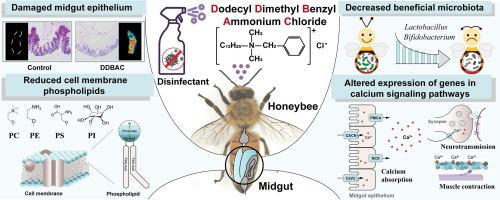Environment International ( IF 11.8 ) Pub Date : 2022-11-15 , DOI: 10.1016/j.envint.2022.107639 Qiangqiang Li 1 , Xiaofeng Xue 1 , Suzhen Qi 1 , Liuwei Zhao 1 , Wenwen Zhang 2 , Man Fan 1 , Liming Wu 1 , Miao Wang 1

|
One of the impacts of the Coronavirus disease 2019 (COVID-19) pandemic has been a profound increase in the application amounts of disinfectants. Dodecyl dimethyl benzyl ammonium chloride (DDBAC) is a widely used disinfectant, yet its hazards to non-target species remain largely unknown. We are unaware of any studies assessing DDBAC’s impacts on honeybee, a pollinator species that is a useful indicator of environmental pollution essential for many forms of agricultural production. Here, we assessed the potentially negative effects of DDBAC on honeybees. After conducting a formal toxicity evaluation of DDBAC on honeybee mortality, we detected an accumulation of DDBAC in the honeybee midgut. We subsequently studied the midgut tissues of honeybees exposed to sub-lethal concentrations of DDBAC: histopathological examination revealed damage to midgut tissue upon DDBAC exposure, microbiome analysis showed a decreased abundance of beneficial midgut microbiota, lipidomics analysis revealed a significant reduction in cell membrane phospholipids with known functions in signal transduction, and a transcriptome analysis detected altered expression of genes involved in calcium signaling pathways (that variously function in calcium absorption, muscle contraction, and neurotransmission). Thus, our study establishes that DDBAC impacts honeybee midgut functions at multiple levels. Our study represents an early warning about the hazards of DDBAC and appeals for the proper stewardship of DDBAC to ensure the protection of our ecological environment.
中文翻译:

消毒剂十二烷基二甲基苄基氯化铵 (DDBAC) 在环境相关水平上破坏蜜蜂 (Apis mellifera) 的肠道微生物群、磷脂和钙信号
2019 年冠状病毒病 (COVID-19) 大流行的影响之一是消毒剂的使用量大幅增加。十二烷基二甲基苄基氯化铵 (DDBAC) 是一种广泛使用的消毒剂,但其对非目标物种的危害在很大程度上仍然未知。我们不知道有任何研究评估 DDBAC 对蜜蜂的影响,蜜蜂是一种传粉物种,是许多农业生产形式所必需的环境污染的有用指标。在这里,我们评估了 DDBAC 对蜜蜂的潜在负面影响。在对 DDBAC 对蜜蜂死亡率进行正式毒性评估后,我们检测到 DDBAC 在蜜蜂中肠中积累。我们随后研究了暴露于亚致死浓度 DDBAC 的蜜蜂的中肠组织:组织病理学检查显示 DDBAC 暴露后中肠组织受损,微生物组分析显示有益的中肠微生物群丰度减少,脂质组学分析显示细胞膜磷脂显着减少,具有已知的信号转导功能,转录组分析检测到参与基因表达的改变钙信号通路(在钙吸收、肌肉收缩和神经传递中发挥不同作用)。因此,我们的研究证实 DDBAC 在多个层面影响蜜蜂中肠功能。我们的研究代表了对 DDBAC 危害的早期警告,并呼吁对 DDBAC 进行适当的管理,以确保保护我们的生态环境。脂质组学分析显示,已知在信号转导中具有已知功能的细胞膜磷脂显着减少,转录组分析检测到参与钙信号通路(在钙吸收、肌肉收缩和神经传递中发挥不同作用)的基因表达发生了改变。因此,我们的研究证实 DDBAC 在多个层面影响蜜蜂中肠功能。我们的研究代表了对 DDBAC 危害的早期警告,并呼吁对 DDBAC 进行适当的管理,以确保保护我们的生态环境。脂质组学分析显示,已知在信号转导中具有已知功能的细胞膜磷脂显着减少,转录组分析检测到参与钙信号通路(在钙吸收、肌肉收缩和神经传递中发挥不同作用)的基因表达发生了改变。因此,我们的研究证实 DDBAC 在多个层面影响蜜蜂中肠功能。我们的研究代表了对 DDBAC 危害的早期警告,并呼吁对 DDBAC 进行适当的管理,以确保保护我们的生态环境。转录组分析检测到参与钙信号通路(在钙吸收、肌肉收缩和神经传递中发挥不同作用)的基因表达发生了改变。因此,我们的研究证实 DDBAC 在多个层面影响蜜蜂中肠功能。我们的研究代表了对 DDBAC 危害的早期警告,并呼吁对 DDBAC 进行适当的管理,以确保保护我们的生态环境。转录组分析检测到参与钙信号通路(在钙吸收、肌肉收缩和神经传递中发挥不同作用)的基因表达发生了改变。因此,我们的研究证实 DDBAC 在多个层面影响蜜蜂中肠功能。我们的研究代表了对 DDBAC 危害的早期警告,并呼吁对 DDBAC 进行适当的管理,以确保保护我们的生态环境。



























 京公网安备 11010802027423号
京公网安备 11010802027423号